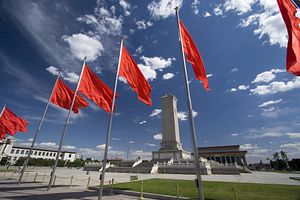How has the West portrayed China over the past 40 years? How has China portrayed the West? And how have these portrayals changed?
These were some of the questions under examination in a recent panel discussion, ChinaFile presents “The New Yorker on China,” moderated by David Remnick, editor of The New Yorker, and featuring the magazine’s China hands: Peter Hessler, Jiayang Fan, Zha Jianying, Evan Osnos, and Orville Schell.
Schell began by describing the labor of reporting from inside China during the 1970s, back when locals evaded any “unauthorized interaction” with journalists. As a result, China then was a nut he couldn’t crack.
“I found it very perplexing,” he confesses, “leaving me wondering exactly what to make of this place.”
So what do you do when you’re looking at a mask and you don’t have the investigative tools to peer underneath? You write about the mask. You write, Schell recalls, about “what China wanted to present itself as and what it wanted you to see.”
It’s a deft solution, but if you’re only looking at a mask, things can easily appear more static than they are. As Schell notes, “there was not one single scintilla of evidence that this place would ever change.”
Even Chinese themselves cannot easily peer beneath the mask of censorship and propaganda, as Zha reveals while telling the story of her first trip to the United States as a student in the early 1980s. Zha was greeted with questions such as “Do you have electricity?” and “Do you eat grasshoppers dipped in chocolate?” For her, such questions signified the American half of a “mutual ignorance.”
However, China did in fact suffer a nationwide electricity shortage from 1979 to 1998 and grasshoppers are a common snack in parts of the country (I’ve had them and they’re delicious). So while I agree with her that “more subtle reporting” is lacking, what these particular examples actually suggest is that our respective masks are so convincing we sometimes mistake outsider knowledge for misconception.
Having said that, merely getting the facts right isn’t enough. Mutual understanding between China and the West is most often hindered by a lack, or utter absence, of societal context.
For instance, Hessler describes textbooks he saw in rural Sichuan that cite statistics about rape at American universities, or people who asked him whether it’s true that the Washington Bullets changed its name to avoid associations with gun violence. As in Zha’s story, the facts were right but the societal context wasn’t there.
Likewise, Fan describes reading about China in Western newspapers for the first time. She compares the experience to seeing an X-ray of China, with all the parts in the right place, but without any flesh — without the life.
Fortunately, the Chinese mask has begun to slip. As Zha observes, Western sources provide misrepresentations that are sometimes worse than what you’d expect from Chinese state media, either depicting China as an “ominous giant” or a “paper tiger that’s on the verge of imminent collapse.” Nevertheless, it’s not as bad as it used to be.
For Hessler, who first entered China in 1996 (22 years after Schell’s initial trip), China was no longer the inscrutable Other. In fact, he says, the biggest challenge was language. Meanwhile, Osnos, who also came in 1996, says the idea that China would never change had by then completely reversed; the default position was now that it was always changing, and like Heraclitus’ stream, you couldn’t set foot in the same China twice.
It therefore seems we’ve gone from a poverty of information to a plethora, leaving us with the same curse as before: the ability to see whatever we wish. As Osnos notes, we see too much of ourselves in China, assuming their changes will inevitably lead to something “similarish” to the West. Or we go the other way, characterizing behavior as uniquely Chinese when it is, in fact, all too human.
Fortunately, the panel agrees that the solution is simple. We have the X-ray. We just need to keep adding flesh. For Fan, that means socioeconomic factors. For Orville, more attention to history. For Hessler, greater geographic context (not just reporting on Beijing and Shanghai). For Osnos, this means psychological depth; reporting on human complexity by balancing the “uplifting” and “dark” elements in a story. And for Zha, it’s about recognizing that China and the West, though very different, are also very much alike.

































